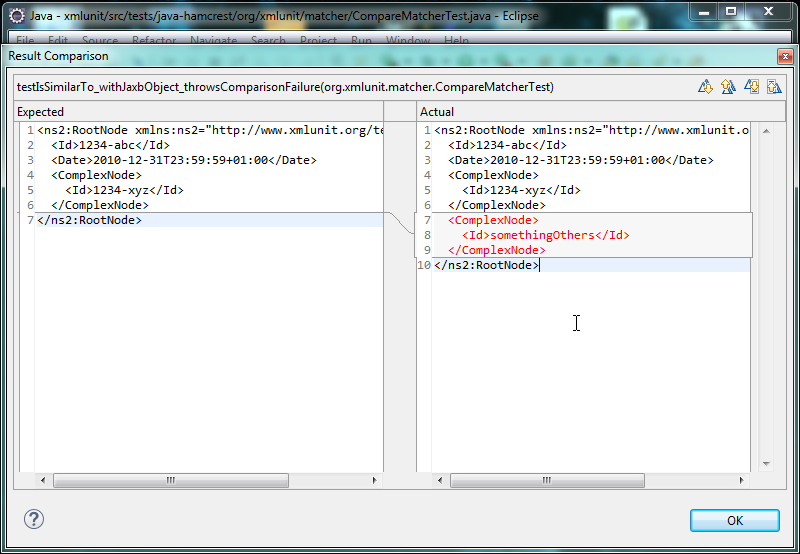CompareMatcher - xmlunit/user-guide GitHub Wiki
XMLUnit for Java provides a Hamcrest matcher named CompareMatcher
and XMLUnit.NET has an NUnit
Constraint1 named CompareConstraint
that can be used to compare two XML sources with each other.
This example will throw an AssertionError: "Expected attribute value
'abc' but was 'xyz'".
final String control = "<a><b attr=\"abc\"></b></a>";
final String test = "<a><b attr=\"xyz\"></b></a>";
assertThat(test, CompareMatcher.isIdenticalTo(control));The corresponding NUnit test code is
string control = "<a><b attr=\"abc\"></b></a>";
string test = "<a><b attr=\"xyz\"></b></a>";
Assert.That(test, CompareConstraint.IsIdenticalTo(control));You can compare any kind of Objects with each other which can be used as a XML sources.
See: Providing Input To XMLUnit - Input.from(Object)
The Difference between identical and similar is decided by the default DifferenceEvaluator unless you override it.
The matcher and constraint can be configured via a fluent API:
CompareMatcher.isSimilarTo(control)
.ignoreComments() // [1]
.ignoreWhitespace() // [2]
.normalizeWhitespace() // [3]
.throwComparisonFailure() // [4]
.withComparisonFormatter(comparisonFormatter) // [5]
.withComparisonListeners(comparisonListeners) // [6]
.withDifferenceEvaluator(differenceEvaluator) // [7]
.withDifferenceListeners(comparisonListeners) // [8]
.withNodeMatcher(nodeMatcher) // [9]
.withAttributeFilter(attributeFilter) // [10]
.withNodeFilter(nodeFilter) // [11]
.withDocumentBuilderFactory(dbf) // [12]
.ignoreElementContentWhitespace(); // [13]and
CompareConstraint.IsSimilarTo(control)
.IgnoreComments() // [1]
.IgnoreWhitespace() // [2]
.NormalizeWhitespace() // [3]
.WithComparisonFormatter(comparisonFormatter) // [5]
.WithComparisonListeners(comparisonListeners) // [6]
.WithDifferenceEvaluator(differenceEvaluator) // [7]
.WithDifferenceListeners(comparisonListeners) // [8]
.WithNodeMatcher(nodeMatcher) // [9]
.WithAttributeFilter(attributeFilter) // [10]
.WithNodeFilter(nodeFilter) // [11]
.IgnoreElementContentWhitespace(); // [13]-
ignoreComments():
will stripping all comments from the test- and control-XML before comparing. -
ignoreWhitespace():
will removing all empty text nodes and trimming the non-empty ones from the test- and control-XML before comparing. If all you need is to remove text nodes solely consisting of whitespace, then you want to useignoreElementContentWhitespace. -
normalizeWhitespace():
will removing all empty text nodes and normalizing the non-empty ones from the test- and control-XML before comparing. With "normalized" in this context means all whitespace characters are replaced by space characters and consecutive whitespace characters are collapsed. -
throwComparisonFailure():
This will throw a org.junit.ComparisonFailure in case of differences. Eclipse, IntelliJ and NetBeans can than show you a nice Diff-View of the differences.
See throwComparisonFailure. This is only available for XMLUnit for Java'sCompareMatcher -
withComparisonFormatter():
Use a custom Formatter for the Error Messages.
See ComparisonFormatter. -
withComparisonListeners():
Registers a listener that is notified of each comparison.
See ComparisonListener. -
withDifferenceEvaluator():
Provide your own custom DifferenceEvaluator implementation.
See DifferenceEvaluator. -
withDifferenceListeners():
Registers a listener that is notified of each comparison with outcome other thanComparisonResult.EQUAL.
See ComparisonListener. -
withNodeMatcher():
Sets the strategy for selecting nodes to compare.
See NodeMatcher. - withAttributeFilter(): Optional strategy that allows certain attributes to be ignore completely. See AttributeFilter.
- withNodeFilter(): Optional strategy that allows certain nodes to be ignore completely. See NodeFilter.
-
withDocumentBuilderFactory():
Use the given
DocumentBuilderFactorywhen creating a document from the test or control source. Only available in XMLUnit for Java - since XMLUnit 2.2.0. - ignoreElementContentWhitespace(): will removing all text nodes solely consisting of whitespace (AKA as element content whitespace) - since XMLUnit 2.6.0.
Instead of Matcher returning false a org.junit.ComparisonFailure will be thrown.
The advantage over the standard Matcher behavior is, that a
ComparisonFailure can provide the effected Control-Node and
Test-Node in separate Properties. Eclipse, NetBeans and IntelliJ can
provide a nice DIFF-View for the two values. ComparisonFailure is
also used in org.junit.Assert.assertEquals(Object, Object) if both
values are Strings:

The only disadvantage is, that you can't combine the CompareMatcher
with other Matchers (like org.hamcrest.CoreMatchers.not(Object))
anymore. The following code will NOT WORK properly:
assertThat(test, not(isSimilarTo(control).throwComparisonFailure()))
1: Actually there are two of them, one for NUnit 2.x and one for NUnit 3.x.